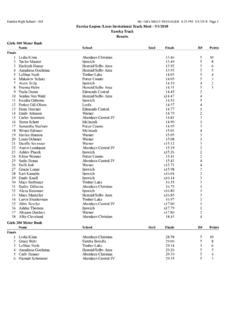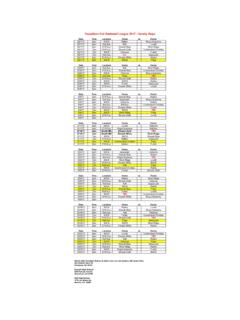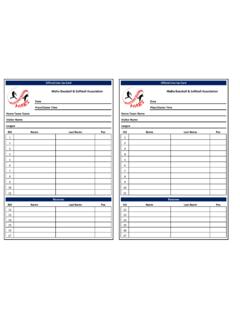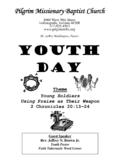Transcription of Sports Nutrition for the Youth & High School Athlete
1 Sports Nutrition for the Youth & high School AthleteFor young athletes (for example: ages 7 12) eating a healthy, balanced diet and getting proper rest are the two most important directives to support the growth phase of athletes in this age group. Protein, carbohydrates, calcium, and iron, are particularly important for healthy bone and muscle growth. Establishing healthy eating habits is especially important at this young age. Adolescence is often the time when eating disorders are established1. Parents that indulge their children s unbalanced diet, for example, too much fast food, sweets, or soda with high fructose corn syrup, may be setting their kids up for eating complications later on and depriving them of important nutrients to support growth.
2 Nutritional requirements do vary by the player, but remember that growth is most important at this early stage, and growth is best supported with a diverse, balanced diet, and sufficient rest. On the topic of food or supplements, in fact, food is the best, least expensive way to achieve proper Nutrition and weight management. Supplements, on the other hand, are often not regulated by the FDA and are almost always more expensive and not as effective at providing Nutrition , especially to young players. The notable exception for supplements is protein shakes the protein in protein powder is often prepared such that it can be utilized by the body more quickly than the protein in lean meats, for example.
3 For young athletes, lean meats (turkey, chicken, lean beef), green vegetables, fruits (in particular bananas, oranges, and apples), milk (if not allergic), potatoes, rice, bread, and peanut butter (if not allergic) are all good examples of food that provides a balanced mix of carbohydrates, protein, calcium, and iron. The importance of calcium should not be underestimated. Calcium is best utilized when it comes from food, rather than vitamins or supplements. It is important that young athletes get enough calcium to support bone growth - Ohio State University s Sports Nutrition department recommends that non lactose intollerant youngsters get four servings from the milk group (milk, cheese, yogurt, cottage cheese) each older athletes that have entered puberty (for example: boys ages 13-18), muscle growth is accelerated with the onset of puberty brought about by the presence of testosterone.
4 It is at this phase of a young Athlete s development that strength training can be introduced, in addition to proper diet, and rest. Strength training, proper diet, and rest will encourage the growth of lean muscle mass. high School football weight training, in particular, can be beneficial in supporting the player s strength and weight goals. With diet and intentional strength training, weight gain of up to 15% per year is not uncommon in this phase of an Athlete s life. Below are two growth chart assuming 15% annual weight 1 Ohio State Universtiy Sports Nutrition : and approximately 1 inch of height growth per year and 10% weight growth per year.
5 Note that these weight growth and height growth assumptions may not be achieved every year. Example Growth chart assuming approximately 15% annual weight growth & approximately 1 inch per year of height growthHeight and weight at beginning of 9th gradeHeight and weight at beginning of 10th gradeHeight and weight at beginning of 11th gradeHeight and weight at beginning of 12th grade5'6"1355'7"1555'8"1795'9"2055'8"140 5'9"1615'10"1855'11"2135'10"1505'11"1736 '0"1986'1"2286'0"1606'1"1846'2"2126'3"24 36'2"1706'3"1966'4"2256'5"2596'4"1806'5" 2076'5"2386'6"274 Tips for gaining lean muscle mass3: Lift weights and condition with a sense of urgency do not just go through the motions, do your best lift hard, run hard, work hard.
6 Attend every workout don t skip workouts. Learn to get comfortable being uncomfortable during workouts push yourself to do your best Never skip meals. Yes, this means you need to get up in time for breakfast, you can t skip lunch, and dinner actually needs to be prepared and eaten. Eat at least five times per day Three meals and two snacks Eat two snacks every day. Mid-afternoon and evening. In order to gain weight you need to fuel your body at regular times. Drink caloric beverages. Choose milk, 100% fruit juice, or Sports drinks when available. Choose calorie-dense foods. That means eating potatoes, corn or peas instead of celery and carrot sticks.
7 Or choosing a banana or cranberry juice instead of an apple or orange juice. Granola cereal is more calorie-dense than puffed rice Eat more when you can. Take seconds and thirds when possible if you are trying to gain weight. Eat protein throughout the day. Players should not count more than 30 grams of protein in one sitting of whole food. For example a huge steak that has 100 grams of protein cannot be counted as 100 grams toward their total number for the day; only 30 of it may be counted. Players should never go more than 2-3 hours without having some source of protein. Protein shakes are OK.
8 If drinking a 100 gram protein shake only 50 grams can be counted during one sitting because its predigested protein that can be utilized immediately. But a player may not eat the food and shake in the one sitting and count it s one or the other. Eat as many carbs as you want. Players can eat as many carbs as they wish in one sitting because carbs are much easier to digest and can be stored, whereas whole food protein cannot be stored and is more difficult to University of Washington Strength and ConditioningExample growth chart assuming 10% weight growth with recommended calories, carb, and protein targetsWeight at start of Frosh yearWeight at start of Soph yearWeight at start ofJunior yearWeight at start of Senior yearExample Target Calories per dayExample Target Carb grams per day Example Target protein grams per dayPlayer weighing 110 lbs to start1101211331463400600130 Player weighing 130 lbs to start1301431571734200740150 Player weighing 150 lbs to start1501651822004300760165 Player weighing 170 lbs to start1701872062264400790170 Player weighing 190 lbs to start1902092302534500800180 Below are some example meal plans for athletes that would like to gain weight.
9 Tailored to a typical high School schedule, based on caloric targets. It s important that athletes eat every 3 to 4 4500 Calorie Meal Plan, tailored to a typical School day and practice schedule6:30 AMBreakfast2 frzen waffles (Nutrigrain) or 1 PB & banana sandwich or 2 bowls cereal2 Tablespoons Peanut Butter (if eating frozen waffles)1 Banana2 cups milk and/or 1 cup yogurt9:00 AMSnackpeanut butter and jelly sandwich or protein bar + water11:30 AMLunch1 Footlong Sub Turkey and Cheese or Two Chicken Sandwiches1 piece of fresh fruit2 cups of juice or milk &/or 1 protein bar2:30 PMSnack prior to 1 protein bar or PB & banana sandwichPractice1 piece of fruit (orange, apple, banana)At least 2 cups water, Sports drink or milk2:30-5:30 PMPractice/Workout6-7 cups of water or Sports drink5:30 PMPost practice snackProtein bar or PB & J sandwich and/or banana, orange7:00 PMDinner6-7oz of grilled steak/chicken / fish / ground beef (extra lean) spaghetti1 baked potato w 1t.
10 Butter or 1 large tortilla1 cup of broccoli, carrots, corn, or beansSalad with dressing1 wheat roll2 cups of milk or Sports drink9:00 PMSnack1 peanut butter and jelly sandwich or PB & banana sandwich1 cup low-fat yogurt &/or 1 cup of milkExample 3500 Calorie Meal Plan, tailored to typical School day and practice6:30 AMBreakfast2 cup oatmeal with 1 cup of low fat yogurt, or 1 Tbsp brown sugar, Banana1 cup milk9:00 AMSnack1 protein bar, 1 PB&J sandwich, and/or fresh fruit11:30 AMLunch1 Turkey/Ham sandwich with mayo1 piece of fresh fruit (banana)1 cup of Sports drink, juice, or milk1 cookie or Sports bar2:30 PMSnack prior to 1 protein bar or PB&J sandwichPractice1 piece of fruit (orange, apple, banana)1 cup Sports drink or milk2:30-5:30 PMPractice/Workout6-7 cups of water or Sports drink5:30 PMPost practice snackprotein bar, PB & J sandwich, and/or banana, orange7.














